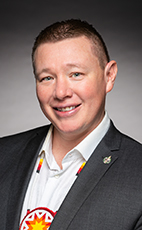44th Parl. 1st Sess.
December 9, 2022 10:00AM
- Dec/9/22 11:03:14 a.m.
- Watch
Madam Speaker, more than three years ago the National Inquiry into Missing and Murdered Indigenous Women and Girls published its report, with over 230 calls for justice. Since then, from the government, there have been lots of pretty words but no action on the scale required, showing utter disrespect for the thousands of victims.
Where is the indigenous-led housing that is needed? Where are the shelters for indigenous women fleeing from violence? The tragic reality of Canada today is that tonight, close to 1,000 indigenous and non-indigenous women and children will be left outside, without access to shelters or services.
The horrific revelation of the deaths of four indigenous women in Winnipeg, murdered by a predator, shows once again that the government has failed to act on the scale that is required to keep indigenous women and girls safe.
To the families of Morgan Harris, Marcedes Myran, Rebecca Contois and the victim whom elders and the community have named Buffalo Woman, we are devastated that this has happened to their loved ones. We will fight to honour their memories.
182 words
All Topics
- Hear!
- Rabble!
- add
- star_border
- share
Madam Speaker, as a first nations person, I know that hunting is a constitutional right that is integral to many nations. Bill C-21's intent is to ban handguns and assault weapons, like AR-15s, full stop. There has been some confusion and there have been some concerns raised, but the committee will get it right.
We will always respect indigenous hunters and their right to pass on that knowledge to their children, like I plan to pass on to my son.
83 words
- Hear!
- Rabble!
- add
- star_border
- share
Madam Speaker, opposition to the Liberals' proposed ban on hunting rifles and shotguns is growing. Yesterday, the Assembly of First Nations issued a declaration opposing Bill C-21 because it attacks treaty hunting rights. The Liberal government claims that there is no relationship more important than that with indigenous peoples, but it failed to consult with first nations, Métis and Inuit.
When will the Liberals admit that they failed to respect the rights of indigenous peoples and scrap Bill C-21?
83 words
- Hear!
- Rabble!
- add
- star_border
- share
Madam Speaker, for more than 20 years I have been going to the Assembly of First Nations. I have been a part of the resolutions. I have been a part of drafting those resolutions. I have been a part of voting on those resolutions.
I applaud the proactive advocacy of first nations when they hear something that they do not quite understand, but I want to make it clear that first nations' hunting rights will always be respected by this government. We know it is a constitutional right. We know there is a constitutional element to this. We will get it right and indigenous hunters will continue into the future.
110 words
- Hear!
- Rabble!
- add
- star_border
- share
Madam Speaker, I want to assure the member opposite that we respect all our hunters and indigenous peoples who rely on hunting. We respect the sustenance rights of indigenous peoples. We are not targeting those rights whatsoever.
What we are going after, what we are banning, what we are trying to take off our streets, are deadly military-style assault guns, the kind that are made to be used on the battlefield. They have no place on our streets. We are going to make sure that we review this legislation carefully and get it right, so that our neighbourhoods are—
101 words
- Hear!
- Rabble!
- add
- star_border
- share
Madam Speaker, we have heard from many northern MPs, who live in different realities from many of us in urban centres. We know there have been concerns. There has been some misinformation on Bill C-21. We know the committee added two extra meetings to make sure we are getting it right, because we always want to make sure we are respecting indigenous hunting rights. Our government will continue to do that. We know it is a constitutional right, but it is also the right thing to do.
88 words
- Hear!
- Rabble!
- add
- star_border
- share
moved that Bill S-219, be read the third time and passed.
She said: Madam Speaker, as always, I want to first begin by acknowledging that I am addressing the House from the unceded territory of the Anishinabe people. At the core of the beliefs of the Anishinabe is a notion of respect. Each element is part of the cycle of life. Each has its purpose and deserves as much respect. Our relationships are what matter the most, and we should cherish them.
I have the immense honour to move Bill S-219 at third reading. I want to thank the member for London West from the bottom of my heart for being my seconder and for all her support and encouragement in making today a reality.
I want to thank my colleagues on all sides of the House for their participation and collaboration. I cannot say enough good things about the members of the Standing Committee on Indigenous and Northern Affairs, who studied this bill and helped ensure its swift passage through the House at all stages. INAN is a shining example of how committees should work.
Each member has made a deep commitment to indigenous peoples across this country, coming from a place of respect and understanding. We were the first committee, I believe, in history to conduct a blanket exercise before our first session to properly set the tone. For those who may not know what a blanket exercise is, it is an experiential learning experience about the story of colonialization. It goes through the true history of Canada, deals with the intergenerational trauma and sets the path toward reconciliation.
I would also like to sincerely thank Senator McCallum and her amazing team for their work, guidance and friendship. I will never forget this experience. I had the incredible good fortune to be gifted a ribbon skirt from the senator to mark this special day. Four colours of the medicine wheel don the skirt, a symbol I have drawn strength from since I was a child. Red, yellow, white and black are represented, symbolizing the people of this world, signifying unity and inclusivity.
I am a non-indigenous woman and I have been invited to be a part of this movement, which speaks volumes and goes to the heart of the bill. There are also three cornstalks featured on the skirt. To me, this represents motherhood, planting a seed and raising my two sweet Wolastoqey wassisok, my children. I am incredibly grateful, and I will cherish my skirt forever.
I also want to note that the main colour is red. The red dress is sacred and represents missing and murdered indigenous women and girls. This week we are in collective mourning for the loss of four more indigenous women in Winnipeg. My heart is with their families. I want to honour them today and add my voice to the call for red dress alerts. No more stolen sisters.
I also want to take a moment to acknowledge my colleague from Nunavut for her advocacy for respect and recognition of Inuit women and girls across Canada. Not all indigenous women wear ribbon skirts, and they have their own traditional regalia with significant meaning. This bill is not meant to pan-indigenize, but to speak to anyone who has been made to feel less than or alienated. It is meant to offer strength and positive celebration.
To the member from Nunavut, I say qujannamiik.
In the words of Senator McCallum, this bill is for Isabella Kulak and her family. I look forward very much to bringing our families together to celebrate this bill, and I am so excited for the prospect of January 4 of 2023 being the first national ribbon skirt day in Canada.
At this time, I would like to read some of the testimony we heard at committee to further highlight the importance and significance of this bill. In the words of the senator:
This bill will create a forum for dialogue within which we can explore the dark side of Canadian history in ways that do not dishearten or shame, but rather inspire us to enact a process of reconciliation for ourselves, both within our communities and the wider Canadian society.
Ribbon skirts themselves are meant to be worn, meant to be danced in, each skirt fashioned with uniqueness, a sign of pride, spirituality, taking back our spirit and making ourselves visible, meant to empower us to be seen. The ribbon skirt will continue our healing and will continue to transmit our history. It is a way to give voice. As we collectively wear our dresses, we gather strength.
Marie‑Josée Wapistan said the following:
This is not just a national day; it is also a day for us to say that our identity will no longer be disrespected. We, women, want respect for our daughters and sisters, who express their identity by wearing their skirt. When we wear a skirt, we are also carriers of life. We, women, are directly connected to mother earth and to all her strength and splendour. She is our nourishing mother.
In the words of Christopher Kulak, Isabella's father, something he and his wife, Lana, often told their children, “You've got to stand up for what's right and what you know to be true in life.” He said:
Bella is brave because she's a small little girl who likes to trap rabbits with her dad and wear sweatpants and go into the woods. It was hard for her to put on that skirt. Sometimes she feels like her skin is a little bit pale to be feeling like a native person, but in her heart she's anishinaabekwe. Her culture and her ceremony give her that, and her ancestry.
I told her: “You wear that with pride. That's where you come from. Your Auntie Farrah Sanderson made that for you, and it comes from all the hard work from your ancestors who worked so hard to keep those traditions alive.”
A poem was read into the record by the senator. It is by Vera Wabegijig and is called jingles speak to the healing. It reads:
we carry our stories on our backssometimes stories are heavy,weighing down, curving the spinelike trees bending from the northern windsometimes stories are sharedlike seeds floating on a summer breezetaking root wherever they landbecoming medicine from the earthour stories take rootground us in the earthso we can gather the strengthto stand like the treesand reach for sky
This bill is about standing up to ignorance and injustice and turning it into something positive and powerful.
I want to acknowledge the 2SLGBTQIA+ people across the land. There is a growing movement of two-spirited powwows and celebrations that ensure safe spaces for all.
I give a special shout-out as well to Kieran Davis of Lac Seul First Nation and Treaty 3 territory for wearing a ribbon skirt at this year's Assembly of First Nations Special Chiefs Assembly and for standing up for gender-diverse voices. I see them, I hear them and I hope to amplify them in the House.
The ribbon skirt is for everyone, and thanks to Isabella Kulak, we can enshrine this reality into law.
To anyone watching at home, keep rocking those skirts and anything else that makes a statement of identity and pride in culture, whether it is moccasin Mondays, traditional Tuesdays, Wolastoq Wednesdays or ribbon skirts every day.
1253 words
All Topics
- Hear!
- Rabble!
- add
- star_border
- share
Madam Speaker, I would like to thank the member for her advocacy not only today but at the INAN committee.
The only thing I am saddened by is that we are not able to see the beautiful ribbon skirt she is wearing. I hope the cameras will pan out as she answers this question so the people at home can see the remarkable skirt she is wearing and the beautiful craftsmanship that indigenous communities continue to promote and recapture after several years of colonization that took away indigenous regalia and indigenous dancing. I have seen and heard of some schools opening up days for children to wear their traditional attire, whether it be ribbon skirts, ribbon shirts or other regalia.
I am wondering if the member could comment on the importance of indigenous peoples reclaiming their traditional attire and culture and it being accommodated in schools, government buildings and all across Canada.
152 words
All Topics
- Hear!
- Rabble!
- add
- star_border
- share
Madam Speaker, I remember an elder talking to me very clearly when I asked a question about colonization and the impacts of all the factors of colonization and what it stole from communities and indigenous people in terms of their traditions and knowledge. I remember the elder told me two things. One is that they worked really hard to maintain and hide what they needed to pass on to their children. On the other side, they believed fundamentally that children born into the earth brought back from the spirit world the traditions that were lost. I am wondering if the member could speak to that.
105 words
All Topics
- Hear!
- Rabble!
- add
- star_border
- share
Madam Speaker, the member for North Island—Powell River is a mother to indigenous children, and I know she is very passionate about sharing those teachings and raising her children to be proud.
Her question reminds me of another story I heard from an elder recently who was speaking about indigenous languages and teachings. One of their children mentioned to them that languages and cultures were in danger of dying out and that they had been hidden. The elder was quick to correct them and said that no, they had always been there, and they are there for the people of today to reclaim and to be proud of. If we listen and seek out these teachings, they are ready for the taking.
Back home in Wolastoqey territory, some proposed the Wolastoqey language would be extinct by now, and it is not. It is revitalized and is thriving, and there are immersion schools. These are all pieces of the puzzle, and it really feels like we are entering this period of healing. That is what reconciliation is all about.
180 words
All Topics
- Hear!
- Rabble!
- add
- star_border
- share
Madam Speaker, first I want to acknowledge the people of this territory, the Anishinabe, for letting us continue to work here. We know that the history is not a good one, but here we are on their territory making the laws of this country.
I also want to take this opportunity to honour all the missing and murdered indigenous women across this country. We know, as we see what has happened in Winnipeg, this raw wound has been ripped open yet again. We know so many people around this country are suffering. I want to recognize and honour the hard work they are doing every moment in surviving this history, surviving this reality now and what that means. Everywhere we go in this country is indigenous land. It is a very special relationship between the first people of that land and the land itself.
I remember years ago speaking with late elder Ellen White from Snuneymuxw. I am so honoured she took the time that she did with me. I expressed my concern about the fact that colonization was continuing to happen, that so much culture was lost due to smallpox, the outlawing of traditional practices, residential schools, day schools and the continued apprehension of indigenous children today. She told me that much of the knowledge was saved, protected and hidden to keep it safe and that everything that was lost came back in the children who were born. They were the carriers of knowledge from the spirit world, so that nothing was ever really lost. That had a really significant impact on me.
When I look at Bill S-219, a bill to make January 4 national ribbon skirt day, it makes me think of how, in spite of everything, in spite of such a targeted effort to destroy the first peoples of this land, they are still here. It makes me think of how the children keep bringing things back to our communities in so many ways. Indigenous children carry inside them this beautiful spirit that will not bend in the face of discrimination, hate or shaming. Therefore, when we think specifically about this day, we have to think about Isabella Kulak who, at 10 years old, inspired a movement based on the pride she had in herself, in her family and in her culture by wearing a ribbon skirt to school.
From the Cote First Nation in Saskatchewan, she wore her ribbon skirt to a formal event at her school. Sadly, an educational assistant made fun of her. Why any adult would feel the need to make a child feel small I can just never understand. The pain perpetrated on children's bodies and spirits over history has never made any sense to me. Indigenous children, for far too many generations, have continued to experience this pain and suffering, and collectively in this place we must all fight to make it stop.
However, this did not prevent Isabella from having her own sense of pride in her family or her family's determination to support her. This moment of shaming was made into something powerful and beautiful. In solidarity, women and men wearing their ribbon skirts and shirts walked Isabella to school in January, and people from around the globe began to post ribbon skirt photos in her name.
I remember my Granny Minnie, from Stellat'en First Nation, who went to Lejac residential school, used to always say to me, “We are still here.” I remember as a child not understanding what that meant. I just knew that we were here. As I got older and learned about the history and what that meant for my granny, I understood that what she meant was that, no matter what happened, we just found a way to survive in those communities. I have such deep respect for that. I often tell people, when they express pity for indigenous communities, that I hope they have compassion but that I hope they recognize how powerfully strong indigenous peoples are because they are still here.
I want to recognize those moments of solidarity, moments when we stand with indigenous children, hold them up and keep them strong in the face of so many challenges. We know that the support for Isabella became much bigger than her community and spread across Canada. Her love for culture, family and community made her famous, and that is beautiful.
I am in support of this bill because pride of first nations, Inuit and Métis culture is part of the restoration of communities that have experienced genocide in this country, but it is also a significant part of Canada becoming a much better and stronger country.
I cannot help but think of my son, Henry. He comes from Homalco First Nation, Coast Salish Nation. Those people always wore cedar. I remember when he was a young person, he worked with an incredible, powerful weaver, Shyanne Watters. He made himself a cedar hat. It was not made in the traditional way; he actually made a cedar top hat. It is beautiful, and it has a very important place in our house. As he got older, he would wear it to high school on their fancy Fridays. Every fancy Friday, he would wear a suit or a vest and his cedar top hat. I watched him walk with pride into his school, and was really moved that it was part of his reality and his identity, and he was not going to hide it.
There is no doubt in our children, there is no core doubt in them about who they are and where they come from. We have to continue to fight for that to be a reality for all indigenous children. They know where their territory is under their feet, and I am so proud of them.
Honouring national ribbon skirt day on January 4 is important, and I look forward to supporting this bill.
993 words
All Topics
- Hear!
- Rabble!
- add
- star_border
- share
Madam Speaker, I thank everyone who participated today and, again, everyone who has helped make this a reality.
Ribbon skirts, much like reconciliation, are for everyone. It makes me think of the new name for our friendship centre back home, Monogonuwicik, which means people of the rainbow. It is about that inclusivity. It is about bringing everyone together. Like I have said many times in the House, it is so important that we honour indigenous women and girls across this country because that, to me, is the fundamental key towards that meaningful reconciliation. Today, we have taken a very big step forward in doing that. I am so grateful.
109 words
All Topics
- Hear!
- Rabble!
- add
- star_border
- share
- menumenu
- notificationsnotifications
- home
- mailmail
- searchsearch








